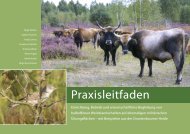TAGUNGSBAND CONFERENCE PROCEEDINGS - Offenlandinfo
TAGUNGSBAND CONFERENCE PROCEEDINGS - Offenlandinfo
TAGUNGSBAND CONFERENCE PROCEEDINGS - Offenlandinfo
Erfolgreiche ePaper selbst erstellen
Machen Sie aus Ihren PDF Publikationen ein blätterbares Flipbook mit unserer einzigartigen Google optimierten e-Paper Software.
Restoration of semi-natural grasslands<br />
in Slovakia<br />
Miriam Kizeková, Norbert Britaňák, Jozef Čunderlík,<br />
Ľubomír Hanzes, Jana Martincová, Štefan Pollák<br />
Production Research Centre Piešťany, GMARI, Banska Bystrica,<br />
Slovakia<br />
Semi-natural grasslands belong to the most valuable<br />
ecosystems within the agricultural landscapes. At present<br />
semi-natural grasslands are in different developmental<br />
stages in Slovakia and their state is mainly determined by<br />
management. European policy has been had a positive<br />
effect on improvement condition and species diversity of<br />
semi-natural grasslands in Slovakia.<br />
Since 2000 several guidelines has been published that<br />
include rules or methodologies how to maintain favourable<br />
conditions of semi-natural grasslands based mainly on<br />
grassland management such is mowing, grazing, mulching,<br />
folding etc. However, there has not existed any methodology<br />
how to improve intensified grasslands or restore<br />
a degraded agricultural land in Slovakia. Guidelines only<br />
recommend some measurements, because there is a lack<br />
of experiences with establishment or restoration of species<br />
rich grasslands with various kinds of plant material.<br />
Therefore in 2009 three demonstration trials were established<br />
in central Slovakia. The aim of the trials was to<br />
compare the success of use of plant material from two<br />
plant communities for the establishment of species rich<br />
grasslands on two different restored receptor sites:<br />
• fresh seed-rich plant clipping material from donor site<br />
plant communities of alliance Arrhenatherion and<br />
Mesobromion on arable land,<br />
• fresh seed-rich plant clipping material from donor site<br />
plant communities of alliance Arrhenatherion on degraded<br />
grasslands with monoculture of Festuca arundinacea<br />
Schreb.<br />
Higher biodiversity was observed on trials established on<br />
arable land where 22 of 26 target species were transferred<br />
and especially trial with alliance Mesobromion was very<br />
similar to the donor site habitat. On the other hand, improvement<br />
of species diversity of degraded grassland with<br />
dominance of such grass species as Festuca arundinacea is<br />
more difficult and need additional intervention which suppress<br />
very vital grass species and allow introducing more<br />
target species from the donor site.<br />
16<br />
Grassland restoration using regional<br />
seed mixtures in the Bile Karpaty Mts.,<br />
Czech Republic<br />
1, 2<br />
Ivana Jongepierová<br />
1 Administration of the White Carpathians Protected Landscape<br />
Area, Luhačovice, Czech Republic<br />
2 Czech Union for Nature Conservation, Local Chapter (ZO<br />
ČSOP) Bílé Karpaty, Veselí nad Moravou, Czech Republic<br />
The White Carpathian Mountains, in the eastern part of the<br />
Czech Republic, Central Europe, were historically covered<br />
by tens of thousands of hectares of species-rich grasslands<br />
used as hay meadows. The majority of these grasslands<br />
were ploughed, heavily fertilised or abandoned between<br />
1950 and 1990, leaving about 4000 ha of ancient meadows<br />
today.<br />
However, since the 1990s approximately 7000 hectares of<br />
arable land have been returned to grassland by means of<br />
spontaneous succession, sowing grass-clover commercial<br />
seed mixtures, and since 1999 also sowing a regional seed<br />
mixture.<br />
The regional mixture contains 85–90 % grasses, 3–5 % legumes,<br />
and 7–10 % other forbs (weight percentage) and the<br />
seed rate is 17–20 kg.ha-1 . This mixture consists of seeds obtained<br />
from existing species-rich meadows in two ways: (1)<br />
reproduction of collected seed (all forbs and some regional<br />
grasses), (2) harvesting with a combine or brush harvester.<br />
Until 2007 small amounts of commercial grass seed were<br />
sometimes added. With this regional seed mixture about<br />
500 ha of arable land have been transformed in to grassland<br />
at 35 localities.<br />
To investigate the development of these new meadows,<br />
their vegetation was analysed in 2009 at sites restored<br />
between 1 and 11 years ago and was compared with that of<br />
ancient, extremely species-rich grasslands nearby. Nearly<br />
all (98 %) of sown species had successfully established and<br />
moreover, nearly half of unsown target species, occurring<br />
in the ancient grasslands, established spontaneously. In<br />
2010 also other sites, regrassed by spontaneous succession<br />
or grass-clover commercial seed mixtures, were analysed.<br />
Using the regional seed mixture is an effective way of<br />
restoring species-rich grasslands as a functional ecosystem,<br />
especially in the proximity of ancient grasslands.




